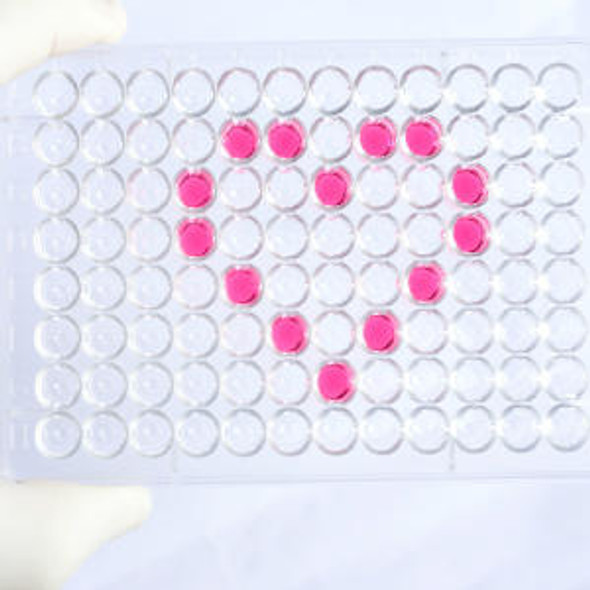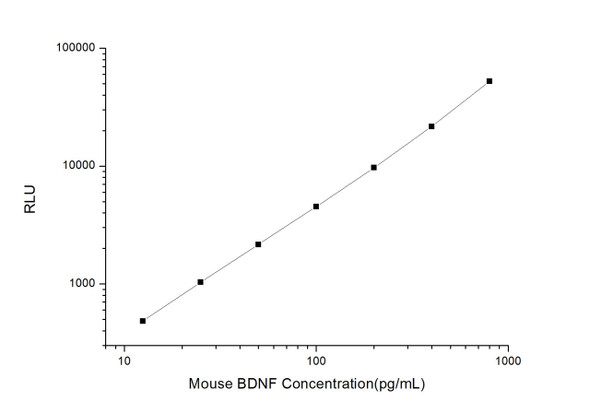Human Cell Biology ELISA Kits 3
Human BDNF (Brain Derived Neurotrophic Factor) CLIA Kit (HUES00010)
- SKU:
- HUES00010
- Product Type:
- ELISA Kit
- ELISA Type:
- CLIA Kit
- Size:
- 96 Assays
- Sensitivity:
- 46.88pg/mL
- Range:
- 78.13-5000pg/mL
- ELISA Type:
- Sandwich
- Synonyms:
- ANON2, BULN2
- Reactivity:
- Human
- Sample Type:
- Serum, plasma and other biological fluids
- Research Area:
- Cell Biology
Description
| Assay type: | Sandwich |
| Format: | 96T |
| Assay time: | 4.5h |
| Reactivity: | Human |
| Detection method: | Chemiluminescence |
| Detection range: | 78.13-5000 pg/mL |
| Sensitivity: | 46.88 pg/mL |
| Sample volume: | 100µL |
| Sample type: | Serum, plasma and other biological fluids |
| Repeatability: | CV < 15% |
| Specificity: | This kit recognizes Human BDNF in samples. No significant cross-reactivity or interference between Human BDNF and analogues was observed. |
This kit uses Sandwich-CLIA as the method. The micro CLIA plate provided in this kit has been pre-coated with an antibody specific to Human BDNF. Standards or samples are added to the appropriate micro CLIA plate wells and combined with the specific antibody. Then a biotinylated detection antibody specific for Human BDNF and Avidin-Horseradish Peroxidase (HRP) conjugate are added to each micro plate well successively and incubated. Free components are washed away. The substrate solution is added to each well. Only those wells that contain Human BDNF, biotinylated detection antibody and Avidin-HRP conjugate will appear fluorescence. The Relative light unit (RLU) value is measured spectrophotometrically by the Chemiluminescence immunoassay analyzer. The RLU value is positively associated with the concentration of Human BDNF. The concentration of Human BDNF in the samples can be calculated by comparing the RLU of the samples to the standard curve.
| UniProt Protein Function: | BDNF: During development, promotes the survival and differentiation of selected neuronal populations of the peripheral and central nervous systems. Participates in axonal growth, pathfinding and in the modulation of dendritic growth and morphology. Major regulator of synaptic transmission and plasticity at adult synapses in many regions of the CNS. The versatility of BDNF is emphasized by its contribution to a range of adaptive neuronal responses including long-term potentiation (LTP), long-term depression (LTD), certain forms of short-term synaptic plasticity, as well as homeostatic regulation of intrinsic neuronal excitability. Defects in BDNF are a cause of congenital central hypoventilation syndrome (CCHS); also known as congenital failure of autonomic control or Ondine curse. CCHS is a rare disorder characterized by abnormal control of respiration in the absence of neuromuscular or lung disease, or an identifiable brain stem lesion. A deficiency in autonomic control of respiration results in inadequate or negligible ventilatory and arousal responses to hypercapnia and hypoxemia. CCHS is frequently complicated with neurocristopathies such as Hirschsprung disease that occurs in about 16% of CCHS cases. Belongs to the NGF-beta family. 5 isoforms of the human protein are produced by alternative promoter. |
| UniProt Protein Details: | Protein type:Secreted, signal peptide; Cell development/differentiation; Secreted; Cytokine Chromosomal Location of Human Ortholog: 11p13 Cellular Component: extracellular space; synaptic vesicle; mitochondrial crista; perinuclear region of cytoplasm; cytoplasmic membrane-bound vesicle; cytoplasm; dendrite; extracellular region; terminal button; perikaryon Molecular Function:growth factor activity; neurotrophin TRKB receptor binding Biological Process: circadian rhythm; axon guidance; mechanoreceptor differentiation; behavioral fear response; mitochondrial electron transport, NADH to ubiquinone; regulation of neuron differentiation; axon extension; response to hormone stimulus; positive regulation of long-term neuronal synaptic plasticity; response to vitamin A; negative regulation of neuroblast proliferation; ureteric bud development; dendrite development; regulation of retinal cell programmed cell death; feeding behavior; negative regulation of neuron apoptosis; response to electrical stimulus; negative regulation of synaptic transmission, GABAergic; inner ear development; response to food; nervous system development; chronic inflammatory response; response to light intensity; neuron recognition; regulation of short-term neuronal synaptic plasticity; learning; regulation of axon extension; negative regulation of striated muscle development; positive regulation of peptidyl-serine phosphorylation; positive regulation of synaptogenesis; axon target recognition; response to hyperoxia; glutamate secretion; response to hypoxia; response to fluoxetine; nerve development; response to activity; positive regulation of neuron differentiation; regulation of excitatory postsynaptic membrane potential; neurite morphogenesis; transmembrane receptor protein tyrosine kinase signaling pathway; gamma-aminobutyric acid signaling pathway Disease: Bulimia Nervosa, Susceptibility To, 1; Obsessive-compulsive Disorder; Bulimia Nervosa, Susceptibility To, 2; Central Hypoventilation Syndrome, Congenital |
| NCBI Summary: | The protein encoded by this gene is a member of the nerve growth factor family. It is induced by cortical neurons, and is necessary for survival of striatal neurons in the brain. Expression of this gene is reduced in both Alzheimer's and Huntington disease patients. This gene may play a role in the regulation of stress response and in the biology of mood disorders. Multiple transcript variants encoding distinct isoforms have been described for this gene. [provided by RefSeq, Jan 2009] |
| UniProt Code: | P23560 |
| NCBI GenInfo Identifier: | 114900 |
| NCBI Gene ID: | 627 |
| NCBI Accession: | P23560. 1 |
| UniProt Secondary Accession: | P23560,Q598Q1, Q6DN19, Q6YNR2, Q6YNR3, Q9BYY7, Q9UC24 A7LA85, A7LA92, D3DQZ2, |
| UniProt Related Accession: | P23560 |
| Molecular Weight: | 31,116 Da |
| NCBI Full Name: | Brain-derived neurotrophic factor |
| NCBI Synonym Full Names: | brain-derived neurotrophic factor |
| NCBI Official Symbol: | BDNF |
| NCBI Official Synonym Symbols: | ANON2; BULN2 |
| NCBI Protein Information: | brain-derived neurotrophic factor; abrineurin; neurotrophin |
| UniProt Protein Name: | Brain-derived neurotrophic factor |
| UniProt Synonym Protein Names: | Abrineurin |
| Protein Family: | BDNF/NT-3 growth factors receptor |
| UniProt Gene Name: | BDNF |
| UniProt Entry Name: | BDNF_HUMAN |
As the RLU values of the standard curve may vary according to the conditions of the actual assay performance (e. g. operator, pipetting technique, washing technique or temperature effects), the operator should establish a standard curve for each test. Typical standard curve and data is provided below for reference only.
| Concentration (pg/mL) | RLU | Average | Corrected |
| 5000 | 59040 63472 | 61256 | 61233 |
| 2500 | 31634 37074 | 34354 | 34331 |
| 1250 | 18407 17931 | 18169 | 18146 |
| 625 | 9327 9457 | 9392 | 9369 |
| 312.5 | 5208 4458 | 4833 | 4810 |
| 156.25 | 2673 2349 | 2511 | 2488 |
| 78.13 | 1260 1418 | 1339 | 1316 |
| 0 | 22 24 | 23 | -- |
Precision
Intra-assay Precision (Precision within an assay): 3 samples with low, mid range and high level Human BDNF were tested 20 times on one plate, respectively.
Inter-assay Precision (Precision between assays): 3 samples with low, mid range and high level Human BDNF were tested on 3 different plates, 20 replicates in each plate.
| Intra-assay Precision | Inter-assay Precision | |||||
| Sample | 1 | 2 | 3 | 1 | 2 | 3 |
| n | 20 | 20 | 20 | 20 | 20 | 20 |
| Mean (pg/mL) | 275.32 | 499.95 | 2371.43 | 281.93 | 486.78 | 2574.49 |
| Standard deviation | 25.11 | 58.84 | 235.01 | 26.16 | 48.09 | 186.91 |
| C V (%) | 9.12 | 11.77 | 9.91 | 9.28 | 9.88 | 7.26 |
Recovery
The recovery of Human BDNF spiked at three different levels in samples throughout the range of the assay was evaluated in various matrices.
| Sample Type | Range (%) | Average Recovery (%) |
| Serum (n=5) | 95-109 | 101 |
| EDTA plasma (n=5) | 94-112 | 102 |
| Cell culture media (n=5) | 98-111 | 103 |
Linearity
Samples were spiked with high concentrations of Human BDNF and diluted with Reference Standard & Sample Diluent to produce samples with values within the range of the assay.
| Serum (n=5) | EDTA plasma (n=5) | Cell culture media (n=5) | ||
| 1:2 | Range (%) | 100-114 | 97-114 | 92-106 |
| Average (%) | 108 | 105 | 97 | |
| 1:4 | Range (%) | 92-108 | 98-111 | 88-100 |
| Average (%) | 100 | 105 | 95 | |
| 1:8 | Range (%) | 99-116 | 91-106 | 93-108 |
| Average (%) | 107 | 98 | 99 | |
| 1:16 | Range (%) | 87-103 | 89-101 | 88-102 |
| Average (%) | 94 | 95 | 95 |
An unopened kit can be stored at 4°C for 1 month. If the kit is not used within 1 month, store the items separately according to the following conditions once the kit is received.
| Item | Specifications | Storage |
| Micro CLIA Plate(Dismountable) | 8 wells ×12 strips | -20°C, 6 months |
| Reference Standard | 2 vials | |
| Concentrated Biotinylated Detection Ab (100×) | 1 vial, 120 µL | |
| Concentrated HRP Conjugate (100×) | 1 vial, 120 µL | -20°C(shading light), 6 months |
| Reference Standard & Sample Diluent | 1 vial, 20 mL | 4°C, 6 months |
| Biotinylated Detection Ab Diluent | 1 vial, 14 mL | |
| HRP Conjugate Diluent | 1 vial, 14 mL | |
| Concentrated Wash Buffer (25×) | 1 vial, 30 mL | |
| Substrate Reagent A | 1 vial, 5 mL | 4°C (shading light) |
| Substrate Reagent B | 1 vial, 5 mL | 4°C (shading light) |
| Plate Sealer | 5 pieces | |
| Product Description | 1 copy | |
| Certificate of Analysis | 1 copy |
- Set standard, test sample and control (zero) wells on the pre-coated plate and record theirpositions. It is recommended to measure each standard and sample in duplicate. Note: addall solutions to the bottom of the plate wells while avoiding contact with the well walls. Ensuresolutions do not foam when adding to the wells.
- Aliquot 100µl of standard solutions into the standard wells.
- Add 100µl of Sample / Standard dilution buffer into the control (zero) well.
- Add 100µl of properly diluted sample (serum, plasma, tissue homogenates and otherbiological fluids. ) into test sample wells.
- Cover the plate with the sealer provided in the kit and incubate for 90 min at 37°C.
- Aspirate the liquid from each well, do not wash. Immediately add 100µL of BiotinylatedDetection Ab working solution to each well. Cover the plate with a plate seal and gently mix. Incubate for 1 hour at 37°C.
- Aspirate or decant the solution from the plate and add 350µL of wash buffer to each welland incubate for 1-2 minutes at room temperature. Aspirate the solution from each well andclap the plate on absorbent filter paper to dry. Repeat this process 3 times. Note: a microplatewasher can be used in this step and other wash steps.
- Add 100µL of HRP Conjugate working solution to each well. Cover with a plate seal andincubate for 30 min at 37°C.
- Aspirate or decant the solution from each well. Repeat the wash process for five times asconducted in step 7.
- Add 100µL of Substrate mixture solution to each well. Cover with a new plate seal andincubate for no more than 5 min at 37°C. Protect the plate from light.
- Determine the RLU value of each well immediately.






